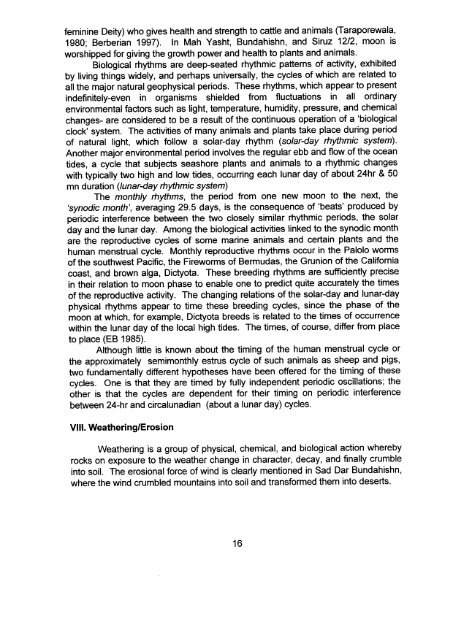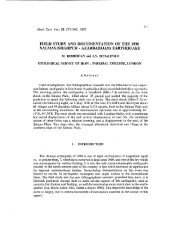PDF COPY - Manuel berberian
PDF COPY - Manuel berberian
PDF COPY - Manuel berberian
Create successful ePaper yourself
Turn your PDF publications into a flip-book with our unique Google optimized e-Paper software.
feminine Deity) who gives health and strength to cattle and animals (Taraporewala,1980; Berberian 1997). ln Mah Yasht, Bundahishn, and Siruz 1212, moon isworshipped for giving the growth power and health to plants and animals.Biological rhythms are deep-seated rhythmic patterns of activity, exhibitedby living things widely, and perhaps universally, the cycles of which are related toallthe major natural geophysical periods. These rhythms, which appear to presentindefinitely-even in organisms shielded from fluctuations in all ordinaryenvironmentalfactors such as light, temperature, humidity, pressure, and chemicalchanges- are considered to be a result of the continuous operation of a 'biologicalclock' system. The activities of many animals and plants take place during periodof natural light, which follow a solar-day rhythm (solar-day rhythmic sysfem).Another major environmental period involves the regular ebb and flow of the oceantides, a cycle that subjects seashore plants and animals to a rhythmic changeswith typically two high and low tides, occurring each lunar day of about 24hr & 50mn duration (lunar-day rhythmic sysfem)The monthly rhythms, the period from one new moon to the next, the'synodicmonth', averaging 29.5 days, is the consequence of 'beats' produced byperiodic interference between the two closely similar rhythmic periods, the solarday and the lunar day. Among the biological activities linked to the synodic monthare the reproductive cycles of some marine animals and certain plants and thehuman menstrual cycle. Monthly reproductive rhythms occur in the Palolo wormsof the southwest Pacific, the Fireworms of Bermudas, the Grunion of the Californiacoast, and brown alga, Dictyota. These breeding rhythms are sufficiently precisein their relation to moon phase to enable one to predict quite accurately the timesof the reproductive activity. The changing relations of the solar-day and lunar-dayphysical rhythms appear to time these breeding cycles, since the phase of themoon at which, for example, Dictyota breeds is related to the times of occurrencewithin the lunar day of the local high tides. The times, of course, differ from placeto place (EB 1985).Although little is known about the timing of the human menstrual cycle orthe approximately semimonthly estrus cycle of such animals as sheep and pigs,two fundamentally different hypotheses have been offered for the timing of thesecycles. One is that they are timed by fully independent periodic oscillations; theother is that the cycles are dependent for their timing on periodic interferencebetween 24-hr and circalunadian (about a lunar day) cycles.Vlll. Weathering/ErosionWeathering is a group of physical, chemical, and biological action wherebyrocks on exposure to the weather change in character, decay, and finally crumbleinto soil. The erosional force of wind is clearly mentioned in Sad Dar Bundahishn,where the wind crumbled mountains into soil and transformed them into deserts.16







